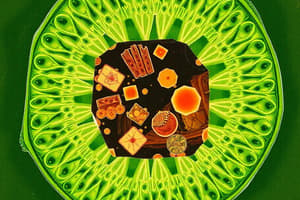Podcast
Questions and Answers
What is the main function of the cell wall in plant cells?
What is the main function of the cell wall in plant cells?
- Regulating cellular respiration processes
- Storing excess water and nutrients
- Producing ATP for energy production
- Maintaining the cell's rigidity and preventing collapse (correct)
Where is the cytoplasm located within a plant cell?
Where is the cytoplasm located within a plant cell?
- Directly attached to the cell membrane
- Inside the vacuoles
- Surrounding the chloroplasts
- Between the cell wall and the nuclear membrane (correct)
Which cellular compartment plays a vital role in transporting water and nutrients across the cell membrane through ion channels and aquaporins?
Which cellular compartment plays a vital role in transporting water and nutrients across the cell membrane through ion channels and aquaporins?
- Cell Wall (correct)
- Vacuoles
- Chloroplasts
- Cytoplasm
What is the primary pigment in chloroplasts responsible for capturing sunlight?
What is the primary pigment in chloroplasts responsible for capturing sunlight?
In plant cells, what is the function of vacuoles?
In plant cells, what is the function of vacuoles?
What is the main function of the cell wall in plant cells?
What is the main function of the cell wall in plant cells?
Which organelle is responsible for converting sunlight into chemical energy in plant cells?
Which organelle is responsible for converting sunlight into chemical energy in plant cells?
Flashcards are hidden until you start studying
Study Notes
Overview of Plant Cells
Plant cells are complex structures composed of several compartments that play essential roles in maintaining their survival, growth, and reproduction. These components include the cell wall, cytoplasm, chloroplasts, and vacuoles. Understanding the function of each part is crucial for understanding how plant cells operate and respond to environmental stimuli.
Cell Wall
The cell wall, which surrounds the plasma membrane, provides support and protection. It is mainly composed of cellulose microfibrils embedded in a matrix of pectin and hemicellulose polymers. This structure gives rigidity to the cell, keeping it upright and preventing it from collapsing under its own weight. In addition to structural functions, the cell wall plays a vital role in transporting water and nutrients across the cell membrane through ion channels and aquaporins embeded within it.
Cytoplasm
The cytoplasm, located between the cell wall and the nuclear membrane, contains all the organelles and molecules necessary for carrying out various cellular processes. Proteins such as enzymes and protein receptors, carbohydrates, lipids, nucleic acids, and other small organic molecules suspended in the cytosol make up this fluid mixture called protoplasm. The heterogeneity of the cytoplasm reveals a dynamic environment where different cellular machineries interact with one another.
Chloroplasts
Chloroplasts are specialized photosynthetic organelles found exclusively in plants, algae, and some protists. They contain pigment-protein complexes called light-harvesting complexes (LHC) and reaction centers responsible for converting sunlight into chemical energy stored in ATP and NADPH. Chlorophyll, the primary pigment involved in capturing sunlight, gives these organelles their green color. During photosynthesis, carbon dioxide from the surrounding atmosphere enters the stroma, the space inside the thylakoid membranes, via small pores called stomata. Here, it is fixed into glucose or sucrose using light energy from the sun.
Vacuoles
Vacuoles are fluid-filled membrane-bound compartments present in most plant cells. They take up a significant portion of the total cell volume in mature cells, often occupying nearly 90% of the cell's volume. Although they serve many purposes depending on the cell type, common functions include serving as storage sites for metabolites like sugars, amino acids, and ions, participating in turgor regulation, and acting as a repository for waste materials. Additionally, in meristematic cells, vacuoles contain large amounts of hydrolytic enzymes that break down cell walls during growth and development.
In conclusion, plant cells consist of multiple interconnected components working together to carry out fundamental biological processes required for life. By understanding the physiological roles of these structures, we gain insights into how plants adapt and survive in diverse environments.
Studying That Suits You
Use AI to generate personalized quizzes and flashcards to suit your learning preferences.



